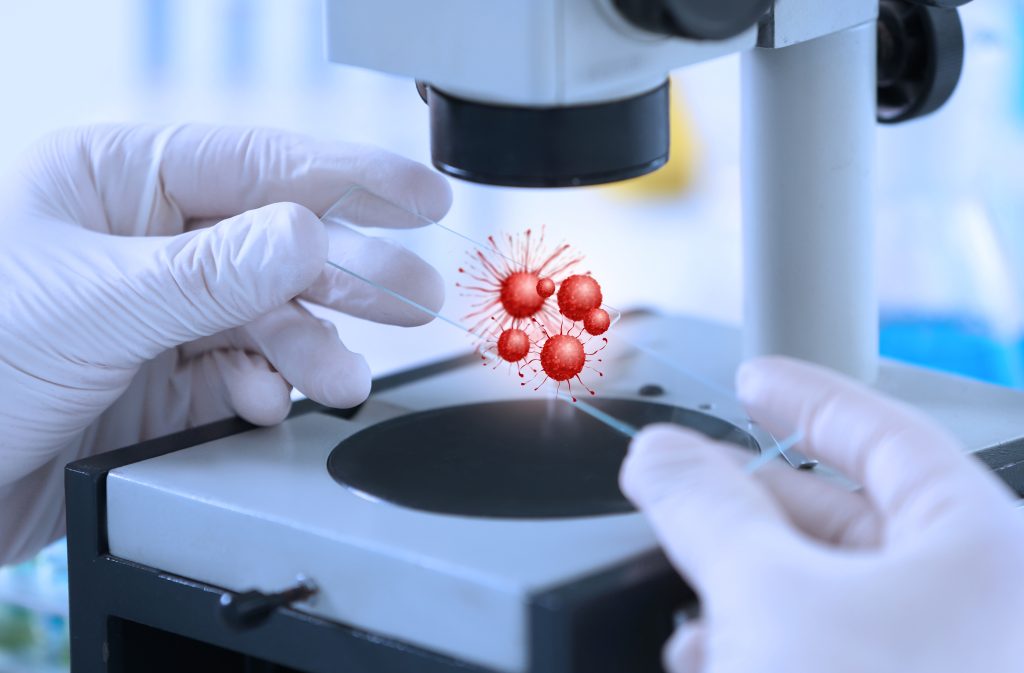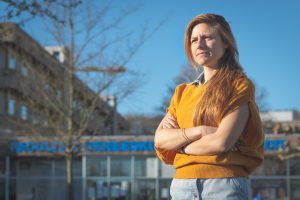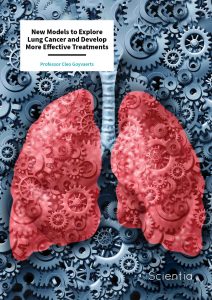Professor Cleo Goyvaerts | New Models to Explore Lung Cancer and Develop More Effective Treatments
Lung cancer is a complex disease that remains extremely difficult to treat. Unfortunately, the conventional methods used to study it in mice have limitations when testing potential treatments. Professor Cleo Goyvaerts and Professor Hélène Salmon from Vrije Universiteit Brussel, Belgium and Institut Curie, France, respectively, worked with colleagues to develop small 3D models of lung tumours using mouse and human cells to help develop new and more effective treatments.
The Challenges of Treating Lung Cancer
Lung cancer is a leading cause of death across the world. As a complex disease with many subtypes, it can be particularly challenging to treat because it often goes undetected until it reaches an advanced stage, making it harder to treat successfully.
Immunotherapy is a new type of cancer treatment that unleashes the body’s immune system to fight cancer. It has been very successful in treating some types of cancer, but it does not work for everyone. Researchers are working to develop new ways to make immunotherapy more effective, and one approach has been to study the tumour microenvironment (TME).
As the name suggests, the TME is the environment around a tumour. It comprises many different types of cells, including immune cells, stromal cells, and blood vessels. The TME can be very immunosuppressive, meaning that it can suppress the anti-tumour activity of the immune system.

Creating 3D Lung Cancer Models
One way to study the TME is to use 3D tumour spheroids. Spheroids are clusters of cells grown in the laboratory to mimic the structure and function of tumours. Researchers have developed new methods for generating 3D lung tumour spheroids that more closely resemble human lung tumours than traditional 2D cell culture models. These models help us better understand lung cancer and test potential treatments more effectively. By mimicking the real-world conditions of lung cancer patients, these models are instrumental in guiding research efforts toward more effective therapies, ensuring that they hold promise for actual patients.
Professor Cleo Goyvaerts and her team at Vrije Universiteit Brussel in Belgium have introduced a straightforward method for generating murine (mouse-based) and human lung tumour spheroids that mimic the multi-cellular TME. These spheroids can be used to study tumour growth, immune cell infiltration, and response to therapy.
The models were made using lung cancer cells from mice and humans engineered to glow green, making them easy to spot under the microscope. They also used special lung fibroblast cells, which provide support and structure to the tumour. Finally, different types of immune cells were added to develop a new assay to test the effectiveness of immunotherapeutic drugs on these spheroids.
Creating these 3D models was like putting together a puzzle. Professor Goyvaerts and the team had to find the right balance between the cancer cells, fibroblast cells, and immune cells. Their goal was to make models that were strong, consistent in size, and formed small clusters of cancer cells. After some experiments, the team was able to craft reliable 3D lung cancer models to drive forward their research.

About 12 hours after mixing lung cancer cells with healthy fibroblast cells at an optimised ratio, 3D lung tumour spheroids are formed. The latter can subsequently be used to study fundamental biological processes and test novel cancer treatments.
Credit: Cleo Goyvaerts.
Pioneering Drug Combinations in 3D Tumour Models
In recent research, Professor Goyvaerts and the team confirmed the exciting potential of a new drug combination to help the body’s immune system fight lung cancer. Their spheroid model allowed the confirmation of earlier results that the combination of two existing drugs – anti-PD-1 and anti-LAG-3 – effectively kills lung cancer cells in the laboratory. This combination of drugs is now undergoing clinical trials in humans, with findings so far indicating that it is both safe and effective in the treatment of lung cancer.
‘Our uncomplicated and reproducible protocol provides a much-needed tool to advance the study and treatment of lung cancer, especially in the framework of immunotherapy.’
Pioneering Research in Tissue Communication
Collaborating with Professor Ahmed Eissa from Warwick University and Wolverhampton University (both in the UK), Professor Goyvaerts and her team have been investigating how different tissues communicate with each other without the need for animal experiments. This line of work aims to better understand how the bone marrow, representing the main source of tumour infiltrating immune cells, talks to lung tumours. More specifically, the researchers are dedicated to finding new ways to grow bone marrow cells on 3D scaffolds in the vicinity of lung tumour spheroids in the laboratory, use advanced techniques to study these cells at the single-cell level, and figure out how these interactions affect cancer outcomes and responses to treatment.
This innovative model will benefit cancer research by further reducing the need for laboratory animals. It will also improve our understanding of biomarkers for lung cancer patients, leading to more effective treatment decisions.
SHARE
DOWNLOAD E-BOOK
REFERENCE
https://doi.org/10.33548/SCIENTIA985
MEET THE RESEARCHER

Professor Cleo Goyvaerts
Laboratory for Molecular and Cellular Therapy
Department of Biomedical Sciences
Vrije Universiteit Brussel
Belgium
Professor Cleo Goyvaerts is a prominent figure in the field of cancer immunotherapy. She completed her PhD in 2015 at Vrije Universiteit Brussel (VUB) on antitumor vaccination. She then completed postdoctoral research both at VUB and Mount Sinai Icahn School of Medicine New York. Returning to VUB in 2018, Dr Goyvaerts was appointed Assistant Professor. She is also a VUB Young Leaders Academy Ambassador for EUTOPIA, a European University Alliance backed by the European Commission. Professsor Goyvaerts has earned considerable recognition, including the International Association for the Study of Lung Cancer Young Investigator Award in 2020, for her contributions to cancer immunotherapy. She is currently leading grant-supported research projects exploring bone marrow-lung cancer interactions and T-cell-mediated killing-resistant mechanisms in lung cancer. Beyond her scientific achievements, Professor Goyvaerts is a dedicated science communicator, bridging the gap between cancer research and society.
CONTACT
W: researchportal.vub.be/en/persons/cleo-goyvaerts
LinkedIn: www.linkedin.com/in/cleogoyvaerts/
KEY COLLABORATORS
- Hélène Salmon, Institut Curie, France
- Ahmed Eissa, Warwick University and Wolverhampton
University, UK - Kirsten De Ridder, Vrije Universiteit Brussel, Belgium
- Robin Maximilian Awad, Vrije Universiteit Brussel, Belgium
- Hannelore Ceuppens, Vrije Universiteit Brussel, Belgium
- Navpreet Tung, The Tisch Cancer Institute, USA
- Jan-Timon Werle, Institut Curie, France
- Léa Karpf, The Tisch Cancer Institute, USA
- Annie Bernier, Institut Curie, France
FUNDING
Fonds Wetenschappelijk Onderzoek
Kom op Tegen Kanker
Belgian American Educational Foundation
Wetenschappelijk Fonds Willy Gepts of the UZ Brussel
Belgian Council Laboratory Animal Science
Association Pour la Recherche sur le Cancer
Marie Skłodowska-Curie Actions
FURTHER READING
K De Ridder, N Tung, J Werle, et al., Novel 3D Lung Tumor Spheroids for Oncoimmunological Assays. Advanced NanoBiomed Research, 2022, 2, 2100124. DOI: https://doi.org/10.1002/anbr.202100124

REPUBLISH OUR ARTICLES
We encourage all formats of sharing and republishing of our articles. Whether you want to host on your website, publication or blog, we welcome this. Find out more
Creative Commons Licence (CC BY 4.0)
This work is licensed under a Creative Commons Attribution 4.0 International License. 
What does this mean?
Share: You can copy and redistribute the material in any medium or format
Adapt: You can change, and build upon the material for any purpose, even commercially.
Credit: You must give appropriate credit, provide a link to the license, and indicate if changes were made.
SUBSCRIBE NOW
Follow Us
MORE ARTICLES YOU MAY LIKE
Dr Ralf Adam | New Technologies Shaping the Future of Oral Hygiene
Understanding the efficiency of various toothbrush technologies is essential for achieving optimal oral health. Dr Ralf Adam, who leads a dedicated team at Procter & Gamble in Germany, is keen to investigate the complexities of these technologies. His team have provided new insights into the best toothbrush types for plaque removal and the maintenance of gum health. By highlighting the importance of informed oral care decisions and ongoing investigations, this vital research works towards ensuring everyone can achieve a brighter, healthier smile.
Dr Toby Phesse | Revealing the Mysteries of Wnt Signalling: Novel Approaches to Beating Cancer
Cancer remains a leading cause of mortality worldwide, and the need for new, more effective treatments remains an urgent challenge. Dr Toby Phesse from Cardiff University in the UK focuses on the role of the Wnt receptor found on the surface of cells and its involvement with cell communication and cancer growth, bringing fresh hopes for new therapeutic options.
Dr Vijay Reddy | The Virus World Database: An Invaluable Resource for Public Health and Healthcare
Severe viral disease presents an ongoing challenge to the health of humankind. While unparalleled developments in science and technology are improving our understanding of such viruses, this information needs to be readily accessible to researchers to ensure continued progress in public health and healthcare. Dr Vijay Reddy and his colleagues at the Hormel Institute (University of Minnesota) developed the Virus World database, an invaluable resource that details the genome, structure, and host of practically every discovered virus to date.
Professor Ralf Herwig | Deciphering the Enigma of Vitamin D and the Immune System
Vitamin D has been studied as a treatment for a large number of diseases and conditions, from cancer to autism to COVID-19. However, its mode of action is not completely understood. Professor Ralf Herwig carries out his research at HG Pharma GmbH (Austria) and Ulster University (UK). His vital work explores the role of vitamin D in the body with a view to unlocking its potential as a treatment for a variety of health conditions involving the immune system.





